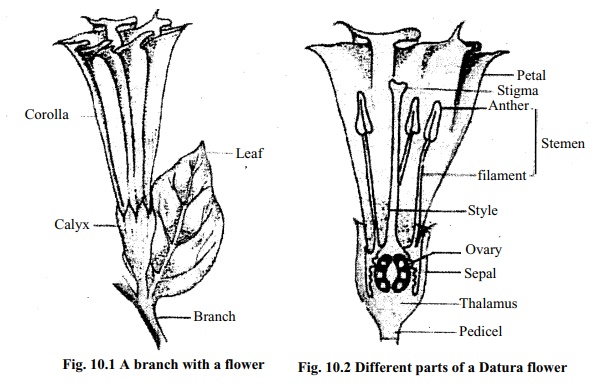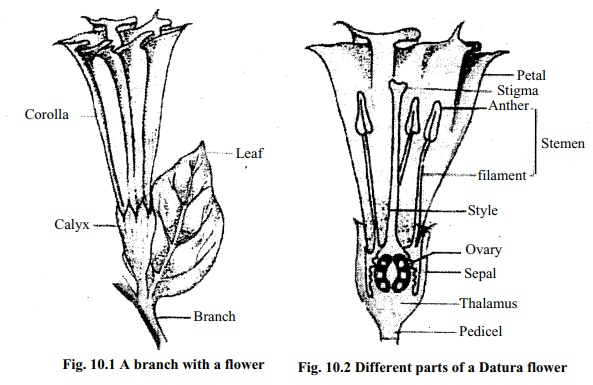Chapter: Biology: Flower
Different Parts of a Flower(Datura Flower)

FLOWER
Flowers are the most beautiful and charming creation of thenature. we all love flowers; trees full of red Shimul, Palash, Madar, or Krishnachura, field full of yellow mustard, beels and Jheels full of violet Kalmilata, hedges full of blue Aparajita, gardens full of roses, China-Roses, Gandhoraj, Kamini, Shephali, Bokul etc. are all dear to us.
Are all these flowers around us are alike? No, if you observe carefully, it will be seen that among them some are red, some are yellow, some are blue or some are white. Again some one of them has strong smell (Hasnahena), some one has sweet smell (Rajanigandha, Chapa, Gandharaj). Again some has no smell at all (Jaba). As There are diversity in colour and smell among them they also differ in structure.
Different Parts Of A Flower:
A flower has several parts. Different parts have several functions. Taking a flower in hand we can observe its different parts. Let us see what parts are there in a'datura [Dhutura] flower. Different parts of Datura flower from out side are:

1. There is a green slender stalk (Pedicel) at the base of the flower the pedicel is swollen. On this swollen part other whorls of the flower are arranged. This part is called thalamus. Thalamus is present in all flowers but all flower not have pedicel. Flower with pedicel is called pedicelate (e.g. Datura, China-rose) and flower without pedicel is called sessile [e.g. Colocasia (Kachu), Polianthus (Rajanigandha)]
Function: To hold other parts of the flower and to attach a sessile flower withstem.
2. Out side the flower there is a green tubelike structure at the base. Top of this tube is splitted into five,segments. From this it is understood that these five segments are combined together to form the tube. This outer green whorl of the flower is called the Calyx. Each of the five parts that comprises the calyx is called a sepal. Sepals may be united together (as in Datura) or may be separated (as in Brassica). In China-rose (Jaba) outside the calyx there is another whorl like the calyx called Epicalyx.
Function: To protect other internal parts in the bud from adverse externalenvironment
3. Next to, petals combined together, to make the corolla. Usually corolla is the show part of the flower. Petals may be united (as in Datura). or may separate from each other [as in Brassica (Sharisha)].
Function: To attract insects and to protect internal parts of the flower.
4. Inside the corolla there is five rod like organ attached at the base. Each of these organs is called Stamen. Each stamen is divided into two parts the slender part is the filament and swollen part at the top is the anther. Inside anther there lies pollen grains. The total stamens of a flower collectively form a whorl, which is called the Androecium.
Function: Main function of the Androecium is to produce pollen grains.
5. The central part of the flower is the Carpel. Swollen part at the base of carpel is the Ovary, long slender part at the middle is the Style and lobbed part at the top is the Stigma. Inside the ovary there are small round parts call Ovules. Ovules later develop to seeds. In Datura flower there are two carpels united together. The whorl of a flower that is formed by one or more carpel called the Gynoecium. The ovary of a flower develops to a fruit. In china-rose five carpels are united to forms the gynoecium.
Function: Functions of the gynoecium is to produce fruits and seeds.
From the above discussion it is understood that a Datura flower has five parts namely: l.thalamus, 2. calyx, 3. corolla,4. androecium or male whorl and (5. gynoecium or female whorl. Among these thalamus is an axis on which other four whorls are arranged.
Datura flower has five parts. But some flowers may have thee or four parts. The flower, which has five parts, is called an ideal flower.
Function of flower: The main function of a flower is to produce fruits andseeds for reproduction of the plant. Androecium and gynoecium are directly involved in seed production, thus they are called essential whorls. Calyx and corolla are called accessory whorls.
Related Topics